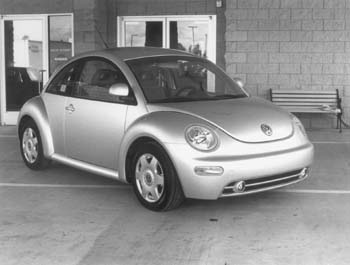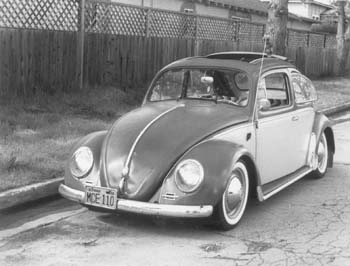Beetle Mania
Toontown Traffic Stopper: With its bulbous contours, the new VW Beetle looks like something that just motored out of a cartoon.
A former Volkswagen mechanic looks beyond the megahype and under the hood to find the soul of a brand-new Beetle
By Eric Johnson
IN PERSON, the New Beetle looks like something out of a cartoon. It looks inflated--as though the Tasmanian Devil had grabbed an old Beetle by the tailpipe and blown it up like a balloon. Inside, it feels enormous. Huge. More headroom than the biggest Chrysler on the lot.
Driving it feels like playing the coolest video game on the Boardwalk. It handles effortlessly. The Fishhook is nothing but an opportunity to pull Gs. Winding through the gears on Highway 1 heading south from River Street, I hit 90 before exiting at Morrissey Boulevard. The speedometer goes up to 140. It probably isn't kidding.
Despite its cartoony appearance, the New Beetle is no joke. It's a real car. But is it really a Beetle?
To get some perspective on that question, I checked with the hardcore enthusiasts at the Volks Cafe. The old VWs they drive sit out behind the shop--Ghias, buses and modified bugs, most in various stages of restoration. I park the New Beetle next to a souped-up VW "Thing" and a four-wheel-drive Vanagon with beefy tires.
Inside the store, owner Peter Jones makes it clear that he has little affection for the gleaming newcomer. Winding his way out through racks of parts, Jones casts aspersions on the car he calls the "Volkswagen Edsel."
"I like the old Beetle," Jones gripes. "This new one is trendy, and there's all this hype, but it's not really a Beetle."
When we get to the car, eight mechanics have it surrounded. Both doors, the hood and the trunk are open, and they're inspecting it enthusiastically. Jones climbs in and unceremoniously reaches for the keys. The guys quickly button the car up, and I'm barely in the passenger seat when we're rolling out of the lot and down Frederick Street.
"Wow," Jones says, almost by accident. But after a short spin around the neighborhood, he holds firm to his position that the New Beetle is little more than a fad.
"They'll sell 50,000 of them on the hype alone," he says. "But it won't catch on. Basically, people will figure out that it's an overpriced toy."
His partner at Volks Cafe, Chris Honig, disagrees passionately. In 10 minutes of chatting about the New Beetle, he uses the word "cool" seven times and "supercool" once.
"It's got a lot of the stuff that made the old Beetle cool, all wrapped up into a new idea," he says. "I like the gear-shifter, the chunky e-brake handle is nice and it's supercool the way the gauge lights up blue. I just can't wait to get my hands on one."
Honig, who makes a living modifying all manner of Volkswagens (he drives an impressively tricked-out '95 Jetta), is trying to convince Jones to buy a Newbee for the shop.
"I've been hot-rodding Bugs since I was 14," Honig says. "Now I want to do that for the new Bugs."
Honig is a master of what is called the "California look" Volkswagen--lowered, dechromed, souped-up and boom-box-equipped. On the New Beetle, however, all that stuff is standard. It's got the air-dam and fog lamps, a two-liter Jetta engine, Porsche suspension, fat tires, fancy rims and big speakers. Where the old Beetle was all Spartan potential, the New Beetle can be bought with Cali cool as standard equipment.
Timeless Machine: Chris Woodall's lovingly customized 1960 rag-top Beetle belies its age with the most famous silhouette in automotive history.
Kit and CaBeetle
IT'S STRANGE to look under the hood of the New Beetle, even knowing there's an engine up front. All you see is a sleek, matte-black plastic cover. A shiny polished-metal intake manifold barely peeks through, looking like the four steel fingers of some big, elegant fist. All the complicated works of the motor itself are hidden under this streamlined barrier. It's a gentle invitation to ignore the unglamorous truth of what makes the car work.
This is an important way that the New Beetle differs from the old. Every part of the engine in the old Volkswagen Beetle was visible at a glance--and it was in the back. It was primarily designed to allow its owner to keep it running. Sure, it was peppy and fun, but the true essence of the old VW was work.
Ferdinand Porsche designed his "Folks Car" as part of Adolph Hitler's plan to build a nation of Übermenschen capable of self-sufficiency. It was a small piece of the sickest worldview in history, but taken alone, the idea that a person should have control of his or her automotive destiny was a good one.
I hate fascists, but I admit here that I was a devotee of Ferdinand Porsche--his automotive theory and his car. For a decade, I was a Volkswagen mechanic. I'd work on Rabbits, Hondas and even certain Toyotas, but air-cooled VWs were my thing.
In theory, the VW was brilliantly engineered. When it was all dialed in just right, the car did everything well. After about 1967, the air-cooled four-cylinder engine delivered good power. It handled like a sports car, got great mileage.
A person could pick one up for $200, patch it together with cheap parts and go anywhere she wanted. That was part of what made VeeDubs cool. On the other hand, anyone who wanted to could turn a Volkswagen into a race car for cheap.
But the best thing about the Volkswagen was that regular people could understand how it worked and fix it themselves. In theory, the Volkswagen was about earning freedom by taking responsibility, and it became a symbol for individuality and independence.
The trunk of every Volkswagen contained a small tool kit--some wrenches and specialty tools tucked in the sleeves of a plastic case that rolled up no bigger than a burrito. With those tools, in theory, Volkswagen drivers were supposed to be relentless in their battle against wear and tear.
Ferdinand Porsche's engineers had designed in a strict regime of tune-ups and oil changes. Every 6,000 miles, VW owners were supposed to replace the points and plugs and set the timing. Every 3,000 miles, they were supposed to slide under the car and adjust the valves.
While they were under there, they were supposed to adjust the brakes with a handy little pry-bar supplied in their kit, and then squirt eight drops of 30-weight on the adjustment screw to prevent rust. The clutch was to be adjusted, paper heater hoses maintained or replaced, dwell set accurately, etc., etc.
In Germany, people actually did all that. But of the 20 million Americans who bought VWs, only a couple of thousand even bothered to read the manual. The rest fell into two categories: those who wisely ignored Porsche's folksy theory and instead took their car to a professional (ahem) and those who let the thing fall apart.
The handful of Beetle owners who took care of the car noticed that it never broke down. But the rest of the VWs in America became what is known among professionals as a piece of shit.
Buying Cool
DESPITE ITS NOBLE and austere heritage, the VW Beetle became the most successful car in American history--not because it was brilliantly engineered, but because Americans thought it was cute, it was fun to drive and, somehow, it was cool. The New Beetle is about that instinct. Where the essence of the Old Beetle was work, the NewBee is definitely about fun.
Beetles have been marketed as fun cars at least since the mid-1960s. But back then, the ads ran somewhat contrary to the reality of the car. Volkswagen ads were whimsical and carefree. Anyone who treated a VW with that attitude ended up with a blown engine.
The ad campaigns for the New Beetle push the nostalgia button, of course, but they also play to the car's technological edge ("Reverse Engineered From UFOs") and countercultural cachet ("If you sold your soul in the '80s, now you can buy it back"). But the hip ads themselves can't account for the level of hype surrounding the New Beetle.
Lee Courtright, who owns Volkswagen of Santa Cruz, doesn't deny that there's a hypefest in progress. An auto dealer for 27 years, Courtright says he's never seen so much hype. He was in a Datsun dealership in 1972 for the release of the 240-Z, then promoted as the world's first low-priced sports car. He witnessed the fanfare when the new-model Corvette was introduced, and when Toyota brought out the racy MR2. Nothing, he says.
Ever since VW unveiled the Concept One prototype in 1994, the buzz has accelerated. When the first batch of Beetles was dropped off in San Francisco last month, Courtright was there. As he and some other dealers drove down Market Street to Union Square, a DJ on KGO announced over the air that the New Ones had arrived.
"There were literally thousands of people lined up on the curbs," Courtright says. "It was like we were the '49ers coming home from winning the Superbowl."
On a drive around Santa Cruz, I saw what Courtright was talking about. Heads were turning up and down Soquel Avenue. High school girls yelled out car windows. People were grinning. One guy on a chopped Harley, gray ponytail hanging from the back of his helmet, turned, smiled and actually flashed me a peace sign.
I was tempted to just drive around town and make people happy. But the open road beckoned. Life is short, and my test drive shorter. I wanted to use this car for what it was really designed for.
[ Santa Cruz | MetroActive Central | Archives ]
Copyright © Metro Publishing Inc. Maintained by Boulevards New Media.
![]()

Robert Scheer
Robert Scheer
From the April 9-15, 1998 issue of Metro Santa Cruz.
![[MetroActive News&Issues]](http://metroactive.com/gifs/news468.gif)